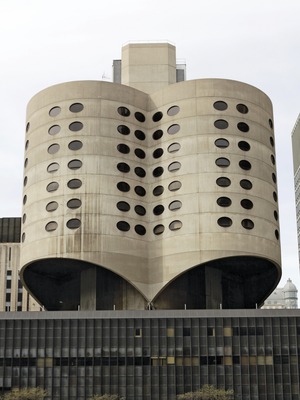Let's Save an Architectural Gem That Also Pioneered Engineering

In the early 1970s, Bertrand Goldberg Associates, my father's architectural and engineering practice in downtown Chicago, was a whirlwind of activity that created many memorable structures. Now, one of his practice's most important creations is threatened by the wrecking ball and Northwestern University. The city of Chicago, where architecture is revered, should preserve it.
During those years, Bertrand Goldberg Associates designed projects at Harvard, Stanford and Northwestern. After a notable success with Marina City in Chicago—the cutting-edge mixed-use complex whose two residential towers, at the time, were the tallest concrete structures in the world—my father and his staff believed they could design and engineer whatever they could imagine.
Interested in social causes, they moved into health care and educational planning for universities. For example, the hospitals featured patient wards arranged in clusters radiating from the nursing station, which minimized the distance between nurse and patient. That became Goldberg's signature.
Prentice Women's Hospital, built for Northwestern, also featured innovations in its unique engineering and construction. The concrete patient tower rose above a conventional base. Designed as a shell structure, it was cantilevered off the building's core so that no columns ran through the base building, only the tower core. Recognized at the time for its uniqueness, Prentice recently was recognized by the National Trust for Historic Preservation.
As an architect in Chicago with my own practice, I can now more fully appreciate Prentice's engineering breakthroughs. An early example of a complex curvilinear structure, the hospital's design relied on finite element analysis, which was not then commonly used for buildings. This level of detail allowed the walls of the tower to be poured with in-place concrete, varying in thickness from 4½ in. to 7½ in. Working with new computer techniques, the office's software engineers adapted software from the aeronautical industry to develop a novel 3D mapping technique. This advance enabled the office's in-house engineers to calculate the structure in weeks, not months.
Mapping 3D Curves
Today, this kind of analysis can be done on a portable PC. While getting any computer to make an engineering drawing was hard enough in 1972, getting one to draw 3D curved structures was nearly impossible. Today, 3D modeling software is a part of any young architect's tool box.
A mainstay of the architecture-school syllabus, radical curvilinear forms now regularly pop up across the U.S. Further, these 3D modeling techniques and tools have spread across the globe, driving cutting-edge designs in, for example, Europe and China.
Designers young and old see the Prentice Women's Hospital as an early precedent from which their own ideas and work derives. The hospital shows how creative engineering can bring together different parts of a building, making it purposeful and dramatic.
The construction of this shell also relied on a contractor willing to stretch. For instance, the front of the building's exposed concrete shell had to be formed and poured just right. It was bare bones—there was no room to hide.
Today, Prentice is threatened. Northwestern hopes to tear it down and build additional research facilities. But other land is available, and re-use options abound. Many people have come together to try to save the structure. Recently, notable architects, engineers and academics signed an open letter calling for Northwestern to change its plan. An enthusiastic young public understands this building is a showcase for engineering.
Innovative combinations of planning, design, engineering and construction are rare. Forty years ago, this building was recognized for these virtues. Long overlooked, its time has come again.
Geoffrey Goldberg practices architecture in Chicago and can be reached at 312-642-3344.





